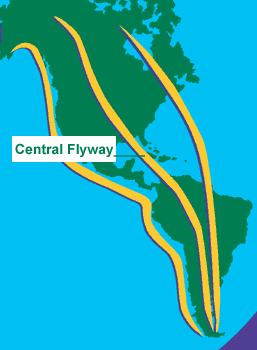American Central Flyway

Route Description
The American Central Flyway covers a wide band of land that extends from the eastern edge of the Rocky Mountains, including the Midwest, the Mississippi River, and the Gulf of Mexico, to the western edge of the Appalachian Mountains. There are four geographic regions within the Central Flyway: the Northern Plains and Prairie Potholes, the Central Plains and Playa Lakes, the Upper Mississippi Valley and Great Lakes, and the
Lower Mississippi and Western Gulf Coast.
Facts About the Flyway
Northern Plains/ Prairie Pothole Region
- This is one of the major migration routes of Western Hemisphere shorebirds. Thirteen species also breed here.
- It encompasses prairies, potholes, and badlands in all or part of seven states.
- There are constantly changing habitat conditions. Shorebirds here are opportunistic.
- Habitat in this area includes rolling hills of prairie grasses, temporary and semi-permanent wetlands, and agricultural fields.
Central Plains and Playa Lakes
- Three stopover sites in this region are part of WHRSN.
- This region supports a large percentage of the hemisphere’s long-distance migrants, including the Stilt and White-rumped Sandpipers.
- Mosaics of temporary wetlands, like playa lakes, are extremely important to shorebirds but are unpredictable in their locations due to weather conditions and hydrological changes from human activities.
- Important habitats in this region include temporary wetlands, agricultural fields, short-grass prairies, freshwater marshes, and rivers.
Upper Mississippi Valley and the Great Lakes
- The region experiences dynamic climate changes and unpredictable habitat conditions.
- Thirty-two species of shorebirds occur in this region.
- Habitats in this region include managed and natural wetlands, river floodplains, lake shoreline, sand and gravel bars, reservoirs, and flooded agricultural fields.
Lower Mississippi and Western Gulf Coast
- A rich variety of shorebird habitats provides important areas for shorebirds in the United States.
- Five highly imperiled shorebirds—the Snowy Plover, Piping Plover, Mountain Plover, Eskimo Curlew, and Long-billed Curlew, have historically been or are presently found along the Gulf Coast.
Shorebirds Most Characteristic of the American Central Flyway
With the exception of the Buffbreasted Sandpiper, shorebirds on this list are common and are readily observed by students. The list is also a “snapshot” of species diversity in the flyway, providing a variety of natural history stories to learn about. Shorebirds that are rare on this flyway are noted with an asterisk. Consider having your
students research these shorebirds using this web site, the library, and the World Wide Web.
- White-rumped Sandpiper
- American Golden-Plover
- Long-billed Dowitcher
- American Avocet
- Upland Sandpiper
- Hudsonian Godwit
- Lesser Yellowlegs
- Buff-breasted Sandpiper*
- Pectoral Sandpiper
- Spotted Sandpiper
 Join In
Join In Archives
Archives